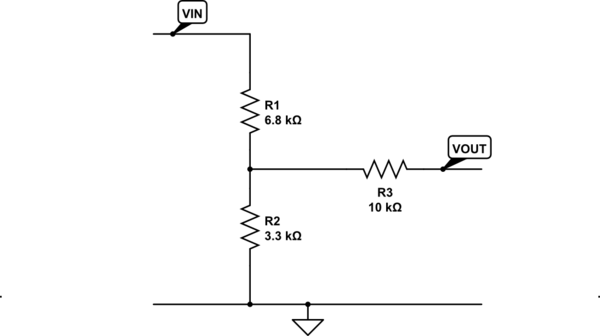Most logic inputs will have a specified maximum current rating. This is the allowable maximum current that can be "forced" into the input without causing problems such as latch up (for instance). It's usually in the realm of 1 mA. To force current into an input means that the input voltage has to exceed the IC voltage supply by (usually) 0.3 volts.
So, if the voltage divider has a Thevenin resistance of 2k22 (6k8 || 3k3), in order to pass 1 mA the unloaded voltage from the potential divider has to be 3.6 volts plus 1mA*2k2 = 5.82 volts.
In effect that means that the input voltage to a 6k8 and 3k3 voltage divider is 17.81 volts. That's a lot more than 10 volts. Is that good enough? It usually is but, there's nothing wrong in placing a 10 kΩ resistor between the potential divider and the logic input for good measure.
A 10 k resistor would drop 10 volts when 1 mA is flowing and this vastly improves the over-voltage withstand capabilities of your circuit.
<!-- Begin schematic: In order to preserve an editable schematic, please
don't edit this section directly.
Click the "edit" link below the image in the preview instead. -->

<!-- End schematic -->
If you were really OCD about it you could add a TVS diode across the 3k3 resistor to limit the voltage to something like 15 volts. That would be fairly bombproof and it's likely the 6k8 would burn before anything bad happened to your precious silicon!!
> *Can't we just use a 'regular' diode from noisy 3.3 V to 3.3 V so that
> any excess voltage will flow to the 3.3 V voltage source*
Many designers will choose this option (usually because of high-speed signal or clock requirements) but there are a couple of things to remember: -
- "Shunting" an excessive voltage to 3.3 volts still means that maybe 4 volts appears at your logic input due to the natural forward volt-drop of silicon diodes (about 0.7 volts).
- If you chose a Schottky diode, the forward volt drop might be 0.3 volts or 0.4 volts so, it's a bit better than a normal diode.
- Pushing current into the 3.3 volt rail system is fine providing you don't excessively "lift" the 3.3 volt rail to a dangerously high voltage that causes your expensive silicon other problems like too much supply voltage. It also injects noise onto the 3.3 volt rail that may also be a problem.
Remember, most voltage regulators expect to see a net current flowing from their output pin and, if driven the other way, they can very often stop regulating. After all, most voltage regulators just use a series pass transistor hence, they can produce current but they can't sink current.